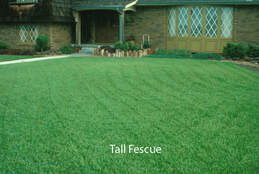 May is an excellent time to fertilize cool-season lawns such as tall fescue and Kentucky bluegrass if they will be irrigated throughout the summer. Non-irrigated lawns often go through a period of summer dormancy because of drought and do not need this fertilization. May is a good time to fertilize because the springtime flush of growth characteristic of these grasses has tapered off, so the fertilizer you apply will be less likely to cause excessive shoot growth than if you fertilized at a full rate in April. Slow-release nitrogen sources are ideal. These nitrogen sources promote controlled growth, which is desirable as the stressful summer weather approaches. Relatively few fertilizers available to the homeowner supply ALL of the nitrogen in the slowly available form. But one such product that is widely available is Milorganite. Other such products available in the retail market include cottonseed meal, alfalfa-based fertilizers, and any other products derived from plants or animals. (Bloodmeal is an exception, and contrary to popular belief, the nitrogen it supplies is quickly available.) These products are all examples of natural organic fertilizers. They typically contain less than 10 percent nitrogen by weight, so compared to most synthetic fertilizers, more product must be applied to get the same amount of nitrogen. Translation: they are more expensive! Apply enough to give the lawn one pound of nitrogen per 1,000 square feet. For example, if the fertilizer is 6 percent nitrogen by weight, you will need to apply almost 17 pounds of fertilizer product per 1,000 square feet. Summer lawn fertilizers that contain at least a portion of the nitrogen as slow-release are fine to use as well. Be sure to follow label directions. If cost is prohibitive, you can use the less expensive quick-release (i.e., soluble) sources, but split the application into two doses as follows: apply enough to give the lawn 0.5 lb nitrogen per 1,000 square feet in May and again in early June. (Ward Upham) 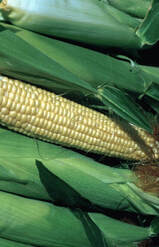 It used to be simple to decide which sweet corn to plant. You simply chose a cultivar and planted when the soil temperature reached 55 degrees. Now it has become more complicated due to genetic advances in sweet corn. Breeders have found certain genes that improve “standard” sweet corn. Below is an overview of the types commonly available to homeowners. Standard (su): This is our “old” sweet corn and contains a “sugary gene” (su). Standard sweet corn should be isolated from field corn, popcorn, supersweets and ornamental corn. To isolate one type of corn from another, do not plant one type within 200 to 250 feet or be sure to have a difference of 12 to14 days in time to maturity. Plant when the soil temperature reaches at least 55 degrees. Recommended varieties include Honey and Cream, Silver Queen, Sterling Silver, Jubilee, or Merit. Supersweet (sh2): Though supersweets have up to three times the sweetness of standard sweet corns and hold their sweetness longer after harvest due to the sh2 gene, they do have some drawbacks such as tougher kernels and a lack of some of that good “corn” flavor. They also need to be isolated from other sweet corn types and are very sensitive to cooler soils. Wait until the soil temperature reaches 65 degrees before planting. Try Candy Store, Florida Staysweet, Sugar Loaf, Sweet Time, or Sweetie. Sugar Enhanced (se): These are probably the most popular type of sweet corn grown due to their tender kernels, good flavor and less sensitivity to cool soils (60 degree soil temperature for planting). They hold their post-harvest sweetness longer than standard types but will not hold sweetness as long as the supersweets. The sweetness from the sugar-enhanced types is due to the “se gene.” If both parents were se types, the variety is known as an se+ or se se. If only one parent was an se type and the other an su type, then the variety will be listed as se. They do not need to be isolated other than from the supersweets. Suggested varieties include Bodacious, Ambrosia, Sweet Temptation, Delectable and Miracle. Triplesweet (synergistic): The newest types of sweet corns blend the su, se and supersweet types with the goal of combining the best characteristics of each. Try Serendipity, Polka, Avalon or Frisky. (Ward Upham) 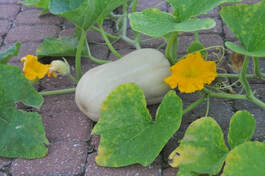 Though early May is a good time to plant most of our warm-season crops such as tomatoes and peppers, it is best to delay planting of winter squash and pumpkins until about mid-June. Planting those two crops now will result in a crop that is mature enough to be attractive to the first generation of squash bugs in July. Delaying until about June 20 will allow plants to escape attack by the first generation. This later planting will also mean that pumpkins will mature closer to Halloween so that long-term storage is not needed. There will be a second generation of squash bugs that will hatch in August. Plant will need to be protected from that generation. See our publication on squash bugs for information on means of control. (Ward Upham) 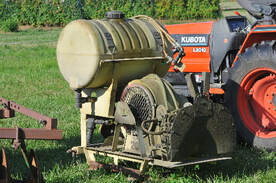 The most common fungicide used in fruit tree sprays is captan. Unfortunately, this product is subject to alkaline hydrolysis. Alkaline hydrolysis is a process whereby certain pesticides will break down when mixed with high pH water. So let’s say you mix up your spray mixture by adding captan to 5 gallons of water. If that water has a pH of 7, the captan will break down so that only half of it will still be present in 8 hours. However, if the water you use has a pH of 10, half the captan will break down in 2 minutes. Malathion used to be the most common insecticide used for fruit pest control by gardeners but is becoming more difficult to find. It isn’t nearly as sensitive to alkaline hydrolysis as captan but still will break down under high pH conditions. Fortunately, it is stable at a pH between 5 and 7. Lambda-cyhalothrin, found in Bonide Fruit Tree & Plant Guard, is a relatively new product for home fruit pest control that also is stable between a pH of 5 to 7. Note that alkaline hydrolysis does not affect all pesticides. Captan is the exception, not the rule. Cornell University has a listing of pesticides and their sensitivity to alkaline hydrolysis. So, how do you bring down the pH of your spray water if it is high? Commercial people use buffering agents but that may be difficult for homeowners to find. Food grade citric acid can help. If you have a pH of 8.0, add 2 ounces of this citric acid per 100 gallons of water (1 and 1/4 teaspoons per 10 gallons) to bring the pH down to about 5.5. If you do not know what the pH of your water is, contact your local Extension office for instructions on how to test. Our K-State Research & Extension website has a map to help you locate your local county Extension office. (Ward Upham) 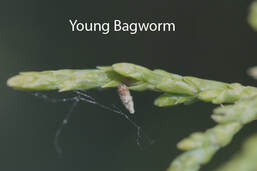 Timing is critical in many things, including controlling bagworms. Though handpicking is effective through much of the year, often it is impractical because of the sheer number of bagworms. However, if you only see a few bags, now would be a good time to pick them off and destroy them. As we mentioned above, large populations of bagworms can make handpicking impractical. In such cases, spraying is recommended. New bagworms will likely hatch and leave the mother's bag in May but spraying is usually not recommended until June. Spraying now will be ineffective because the young are too well protected inside their mother's bag. Watch for an article on when and what to spray a bit later in the season. If you can’t wait, we do have an article on bagworms that should prove helpful. (Ward Upham) 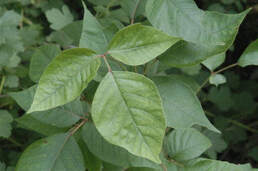 Learning to identify poison ivy is vital if you wish to avoid the rash that accompanies exposure. Unfortunately, poison ivy can make identification difficult because it occurs in three forms: an erect woody shrub, a groundcover that creeps along the ground, and a woody vine that will climb trees. When poison ivy climbs, it forms numerous aerial roots that give the vine the appearance of a fuzzy rope. The leaves of poison ivy also vary. Though the compound leaf always has three leaflets, the leaf margins may be toothed, incised, lobed or smooth. The size of the leaves also can vary, although usually the middle leaflet is larger than the other two. Also, the middle leaflet is the only one with a long stalk; the other two are closely attached to the petiole (leaf stem). The number of leaves gives rise to the saying: "Leaves of three, let it be!" Poison ivy is often confused with Virginia creeper or Woodbine. Each of these vines, however, has five leaflets rather than three. There are three methods commonly used to eradicate poison ivy. These include pulling or grubbing out the plants by hand, cutting off the vine, and then treating the cut stump or the regrowth, and spraying the plants directly. The method used depends somewhat on the plant's growth form. If the plant is growing as a groundcover, direct spray or grubbing the plant out is often used. If grubbing, wear gloves and a long-sleeved shirt. The soil must be moist for grubbing to work well. Wash the clothes and yourself immediately after you finish. It might also be a good idea to rinse the washing machine. If the plant is in the shrub form, direct spray is the most common control method. If the plant is a woody vine that has climbed a tree, the preferred method is to cut the plant off at the base and treat the sprouts after they emerge. Some triclopyr herbicides also have instructions on treating a freshly cut stump directly. Triclopyr (Brush-B-Gon Poison Ivy Killer, Brush Killer Stump Killer) is most often used for poison ivy control. Other herbicides that can be used include glyphosate (Roundup; Killzall Weed and Grass Killer; Nutgrass, Poison Ivy and Vine Killer) or dicamba. Poison ivy is tough. Repeat applications may be necessary. (Ward Upham) 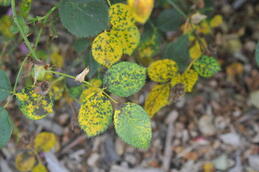 A common disease of roses is blackspot, a fungus disease that can cause defoliation of susceptible plants. Look for dark, circular lesions with feathery edges on the top surface of the leaves and raised purple spots on young canes. Infected leaves will often yellow between spots and eventually drop. The infection usually starts on the lower leaves and works its way up the plant. Blackspot is most severe under conditions of high relative humidity (>85%), warm temperatures (75 to 85 degrees F) and six or more hours of leaf wetness. Newly expanding leaves are most vulnerable to infection. The fungus can survive on fallen leaves or canes and is disseminated primarily by splashing water. Cultural practices are the first line of defense. 1. Don't plant susceptible roses unless you are willing to use fungicide sprays. Purdue University has a list of blackspot resistant cultivars. 2. Keep irrigation water off the foliage. Drip irrigation works well with roses. 3. Plant roses in sun in areas with good air movement to limit the amount of time the foliage is wet. 4. Remove diseased leaves that have fallen and prune out infected rose canes to minimize inoculum. If needed, protect foliage with a regular spray program (10- to 14-day schedule) of effective fungicides. Recommended fungicides include tebuconazole (BioAdvanced Disease Control for Roses, Flowers and Shrubs, BioAdvanced All-In-One Rose & Flower Care), myclobutanil (Immunox, F-Stop Lawn & Garden Fungicide) and chlorothalonil (Broad Spectrum Lawn & Garden Fungicide, Garden Disease Control, others). (Ward Upham) 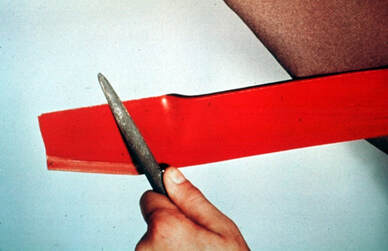 Lawn-mowing season is here. Remember that dull blades give the lawn a whitish cast. A dull blade does not cut cleanly but rather shreds the ends of the leaf blades. The shredded ends dry out, giving the lawn that whitish look. A sharp mower blade is even more important when the turf starts putting up seed heads next month. The seed head stems are much tougher than the grass blades and more likely to shred. Under normal use, mower blades should be sharpened about every 10 hours of use. (Ward Upham) |
AuthorsCynthia Domenghini runs the Horticulture Response Center in the Department of Horticulture and Natural Resources at Kansas State University. Other contributors include K-State Extension Specialists. Archives
March 2024
Categories
All
|
| K-State Research and Extension Horticulture Newsletter |
|
 RSS Feed
RSS Feed
